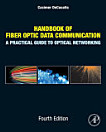Fiber Optic Essentials
Jul 2010 · Elsevier
4.0star
3 reviewsreport
eBook
288
Pages
family_home
Eligible
info
reportRatings and reviews aren’t verified Learn more
About this eBook
This book is a MUST for everyone in and around the optics community! Fiber Optic Essentials provides professionals and students new to the field of fiber optics with a high-level knowledge of principles, theories and applications. This primer can also be used as a succinct overview of optics for those with some engineering and physics background. Individuals involved with optics in non-traditional capacities such as in marketing and legal departments will find this volume introduces basic concepts completely in an easy to read format. Casimer and Carolyn DeCusatis have provided a concise resource with compact chapters and minimal equations conveying this complex topic in a straightforward and clear-cut style. Included in this book are chapters on fibers, cables, connectors, transmitters, modulators, noise, and optical link design. Concluding this reference are three indispensable appendices covering extensive definitions, acronyms (including initials and commonly used slang), measurement conversions and physical constants. This author team has produced a book that has truly shed light on this difficult subject. - Comprehensively covers basic fiber optic 'facts' - Explains how optics relate to everyday life - Details fiber optic communication standards - Chapter included on medical applications - Timeline traces the history of optics with major milestones
Ratings and reviews
4.0
3 reviews
About the author
Dr. Casimer DeCusatis is an IBM Distinguished Engineer and technical executive based in Poughkeepsie, N.Y. He currently serves as Chief Technology Officer for IBM Systems Networking Strategic Alliances, and has played a leading role in developing data center network and I/O solutions, including extended distance connectivity. He is an IBM Master Inventor with over 100 patents, and recipient of several industry awards, including the IEEE Kiyo Tomiyasu Award, the Sigma Xi Walston Chubb Award for Innovation, the EDN Innovator of the Year Award, the Mensa Research Foundation Copper Black Award for Creative Achievement, the Penn State Outstanding Scholar Alumnus Award, and the IEEE/HKN Outstanding Young Electrical Engineer award (including a citation from the President of the United States and an American flag flown in his honor over the U.S. Capitol). He is co-author of more than 120 technical papers, book chapters, and encyclopedia articles, and editor of the Handbook of Fiber Optic Data Communication (now in its 4rd edition). He is a member of the IBM Academy of Technology and co-leader of the Academy study "Innovation Ecosystems. Dr. DeCusatis received the M.S. and Ph.D. degrees from Rensselaer Polytechnic Institute (Troy, N.Y.) in 1988 and 1990, respectively, and the B.S. degree magna cum laude in the Engineering Science Honors Program from the Pennsylvania State University (University Park, PA) in 1986. He is a Fellow of the IEEE, Optical Society of America, and SPIE (the international optical engineering society), a member of the Order of the Engineer, Tau Beta Pi, Eta Kappa Nu, Mensa, and various other professional organizations and honor societies (http://www.decusatis.net/casimer/ ); he was recognized as one of Sigma Xi's Distinguished Members during their 125th anniversary celebration. He is also Founder and Director of Hudson Valley FIRST Lego League (http://www.facebook.com/HudsonValleyFLL) which offers over 1,000 students each year the opportunity to pursue their interest in science and technology. His discussions on data networking are available on Twitter (@Dr_Casimer) or his data networking blog (https://www-304.ibm.com/connections/blogs/DCN/ ).
Rate this eBook
Tell us what you think.
Reading information
Smartphones and tablets
Install the Google Play Books app for Android and iPad/iPhone. It syncs automatically with your account and allows you to read online or offline wherever you are.
Laptops and computers
You can listen to audiobooks purchased on Google Play using your computer's web browser.
eReaders and other devices
To read on e-ink devices like Kobo eReaders, you'll need to download a file and transfer it to your device. Follow the detailed Help Centre instructions to transfer the files to supported eReaders.







